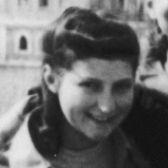
-
Learn More about Rachel
- Collections View Rachel's family papers and photographs
- Echoes of Memory Read Rachel's writings
- First Person Watch Rachel share her Holocaust experiences at a First Person program
- Oral History Access Rachel's Oral Testimony
Rachel (Rae) Mutterperl was born to Beryl and Dina on December 2, 1930, in Dokszyce, Poland (present day: Doksycy, Belarus). Dokszyce was three miles from the Soviet Union border with a population of around 5,000; half of the inhabitants were Jewish. Beryl was a businessman who bought cattle and farm products to export to Germany or sell to the nearby Polish border garrison. Dina owned a thriving fabric store. Rachel’s brother, Shlomo, was three years younger. The Mutterperls lived in the center of town and their businesses were attached to the house and fronted the street, with a large warehouse in the back.
On September 17, 1939, the Soviet Union invaded eastern Poland and Soviet troops occupied Dokszyce. Life for the Mutterperls changed drastically when the Soviet authorities nationalized the family businesses and banned religious schools. Rachel and other Jewish children had to attend Soviet public schools. Beryl became ill and died in 1937 after delivering products to Germany. Following the German invasion of the Soviet Union on June 22, 1941, German troops over ran Dokszyce and the town came under Nazi rule. In July 1941, German authorities required the Mutterperls and other Jewish families to wear yellow badges on the front and back of their garments to identify them as Jews, and designated a small section of Dokszyce near the synagogue as the Jewish ghetto. It was separated from the rest of the town by walls and barbed wire. German authorities forced several families to live in a single room; food quickly became scarce
When German SS and police began mass killings of the Jews in Dokszyce in 1942, Rachel and her family went into hiding, concealing themselves in a double wall between the back of the family home and their former business warehouse. They stayed in their hiding place for over a week before supplies ran out. One night just before the final liquidation, Dina, Rachel, and Shlomo were able to escape from the ghetto. After Dina and her children crossed the Berezina River, a farmer agreed to hide Shlomo, while Dina and Rachel hid at the edge of the village until nightfall. Dina and Rachel were helped by a Polish woman, who allowed them to stay in her house. While there, Dina received word that the Germans had discovered and killed Shlomo and had severely beaten the farmer who had sheltered him. Knowing they were no longer safe in the village, mother and daughter made their way to the ghetto in Glebokie, where they lived with family friends. When Dina and Rachel were both assigned to perform forced labor outside the ghetto walls, it provided another opportunity for escape.
Dina joined a group of partisans, who had formed in the forest outside Glebokie. Dina became the cook for the partisan group and Rachel was her assistant. Expecting the partisans to be effective against the Germans, the Soviets supplied the groups from the air beginning in 1943. In late summer of 1944, Dina and Rachel marched with the partisans to the Soviet lines. After being liberated by the Soviets, mother and daughter returned to Glebokie, but experienced widespread and overt antisemitism from the townspeople. Dina was able to find work as a railroad worker, traveling behind the Soviet front line to repair water towers that had been destroyed by the retreating Germans. Dina and Rachel then made their way to Lublin, where other Jewish survivors were gathering to receive help. They then left Poland for Italy where they stayed in the Santa Cearea and Bari displaced persons’ camps
In 1947, Rachel and Dina immigrated to the United States with sponsorship and support from Beryl’s sister. Rachel married Harvy Goldfarb, a Holocaust survivor and Korean War veteran, in June 1952. They have two children, Lynn and Barry. Rachel was a real estate agent for 30 years and now volunteers at the Museum.
